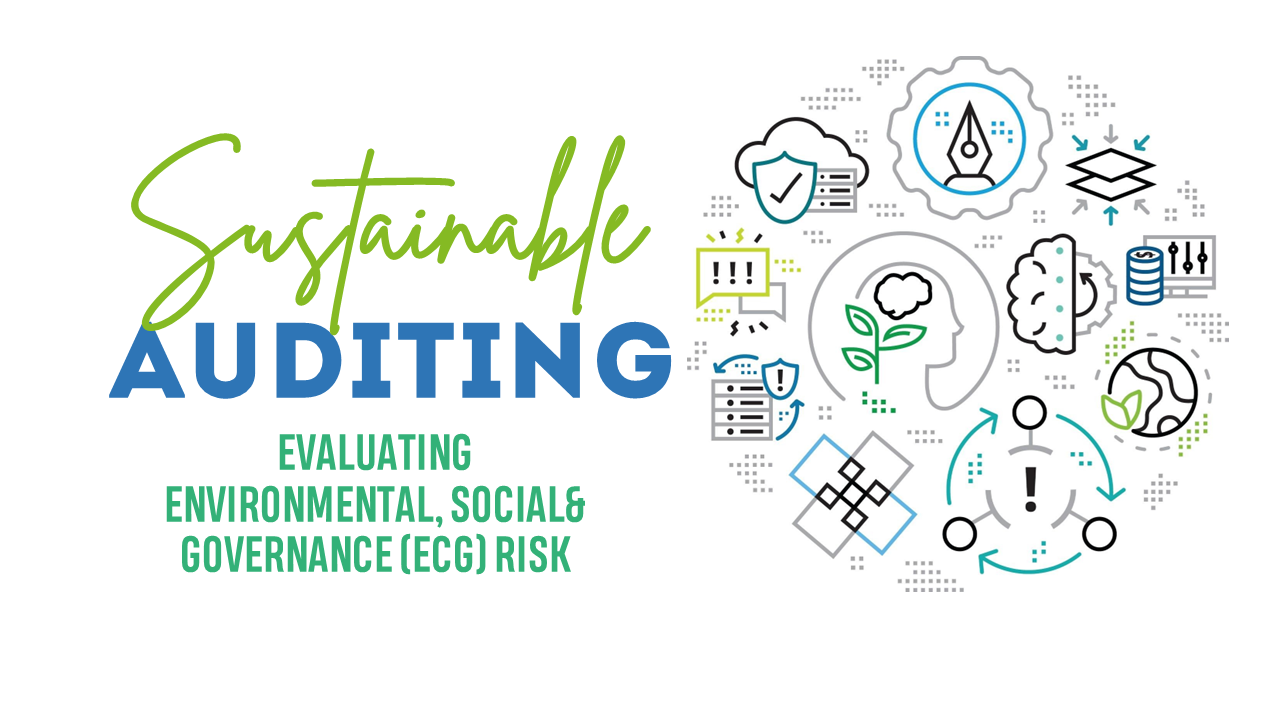SUSTAINABLE AUDITING: EVALUATING ENVIRONMENTAL, SOCIAL AND GOVERNANCE (ECG) RISKS- Part 1
SUSTAINABLE AUDITING
- Sustainable auditing refers to the process of evaluating and assessing an organization's environmental, social, and governance (ESG) practices and performance. It involves examining how well a company manages and mitigates it impact on the environment, society, and its overall governance structure.
- In sustainable auditing, auditors examine various aspects of an organization's operations, policies, and procedures to identify potential risks and opportunities for improvement in terms of sustainability. The goal is to provide an independent and objective evaluation of the company's ESG performance, ensuring transparency, accountability, and adherence to sustainable business practices.
- Through sustainable auditing, organizations can gain insights into their environmental footprint, social impact, and governance practices, enabling them to identify areas of strength and weakness. The audit results can guide decision-making, risk management, and the development of strategies to improve sustainability performance enhance stakeholder trust, and drive long-term value creation.
- Sustainable auditing often follows established frameworks and standards, such as the Global Reporting Initiative (GRI) Sustainability Accounting Standards Board (SASB), and Task Force on Climate-related Financial Disclosures (TCFD), among others. These frameworks provide guidelines and metrics for measuring and reporting ESG performance, facilitating comparability and consistency across organizations and industries.
Importance of Evaluating ESG Risks
Evaluating environmental, social, and governance (ESG) risks is of paramount importance for several reasons:
- RISK IDENTIFICATION AND MANAGEMENT: Evaluating ESG risks allows organizations to identify potential risks and vulnerabilities related to their operations, supply chains, and stakeholders. It helps in assessing the likelihood and impact of ESG risks and developing strategies to manage and mitigate them effectively. By proactively addressing ESG risks, organizations can reduce the likelihood of negative events, such as environmental accidents, reputational damage, regulatory non-compliance, or social unrest.
- FINANCIAL PERFORMANCE & LONG TERM VALUE: ESG risks can have a significant impact performance and long-term value. Factors such as climate change, resource scarcity, labor practices, and governance failures can affect operational efficiency, profitability, access to capital, and investor confidence. Evaluating ESG risks helps organizations integrate sustainability into their business strategies, enhance financial resilience, and create long-term value for shareholders and stakeholders.
- REGULATORY COMPLIANCE & LEGAL OBLIGATION: Governments and regulatory bodies are increasingly imposing requirements and regulations related to ESG practices. Evaluating ESG risks enables organizations to ensure compliance with relevant laws and regulations, minimizing the potential for legal and regulatory penalties. Moreover, it helps organizations stay ahead of evolving regulations, anticipate future compliance requirements and effectively manage regulatory risks.
ENVIRONMENTAL RISKS
What are Environmental Risks
Environmental risks refer to potential hazards or adverse impacts on the environment resulting from human activities. These risks can have far-reaching consequences for ecosystems, natural resources, biodiversity, and human well-being.
Types of Environmental risks & its Impact
| CLIMATE CHANGE | Rising global temperatures, altered weather patterns, sea-level rise, and increased frequency and intensity of extreme weather events.
|
| AIR POLLUTION | Emission of pollutants into the atmosphere from industrial activities, transportation, and energy
generation. |
|
WATER POLLUTION |
Contamination of freshwater sources, such as rivers, lakes, and groundwater, due to industrial waste agricultural runoff, and improper sewage disposal. |
|
LAND DEGRADATION |
Deforestation, soil erosion, desertification, and loss of fertile land due to unsustainable agricultural practices, urbanization, and mining activities |
| WASTE GENERATION |
Improper waste disposal, excessive use of non-recyclable materials, and inadequate waste management systems
|
| RESOURCE DEPLETION |
Overconsumption and depletion of finite resources, including fossil fuels, minerals, and freshwater. |
Key Areas of Assessment
- ENERGY & RESOURCE CONSUMPTION
- Assessment of energy consumption: This involves analyzing the organization's energy usage patterns, including electricity fuel, and other energy sources. Evaluating energy consumption helps identify opportunities for energy efficiency improvements, renewable energy adoption, and reducing carbon footprint.
- Resource consumption assessment: This entails evaluating the organization's use of natural resources, such as water, raw materials, and minerals. Assessing resource consumption helps identify areas where resource efficiency measures can be implemented, waste can be minimized, and sustainable sourcing practices can be adopted.
- POLLUTION & WASTE MANAGEMENT
- Pollution assessment: This involves evaluating the organization's emissions of air pollutants, water pollutants, and hazardous substances. It includes assessing compliance with regulatory standards, monitoring pollution levels, and identifying strategies for pollution prevention and control.
- Waste management assessment: This entails evaluating the organization's waste generation, disposal practices, and recycling efforts. It includes assessing waste reduction strategies, promoting recycling and reuse, and implementing proper waste management practices to minimize environmental impacts
- CLIMATE CHANGE IMPACT
- Greenhouse gas (GHG) emissions assessment: This involves quantifying and evaluating the organization's emissions of GHGs, including carbon dioxide (CO2), methane (CH4), and nitrous oxide (N2O). It includes assessing emissions from direct operations (Scope 1), purchased energy (Scope 2), and value chain activities (Scope 3). Evaluating GHG emissions helps identify areas for reduction, set emission reduction targets, and track progress towards mitigating climate change impact.
- Climate change vulnerability assessment: This entails assessing the organization's vulnerability to the impacts of climate change, such as sea-level rise, extreme weather events, and changing precipitation patterns. It includes evaluating potential risks to infrastructure, supply chains, and operations, as well as identifying adaptation measures to enhance resilience.
Examples of Risk Evaluation
SOCIAL RISK
What is Social Risk?
Social risk is a crucial component of environmental, social, and governance (ESG) considerations. It refers to potential risks and adverse impacts on social factors that can affect organizations, communities, and stakeholders. Evaluating social risks helps organizations understand and address issues related to human rights, labor practices, community relations, and product safety.
Impact of Social Risk
- REPUTATIONAL DAMAGE
- Social risks, such as human rights violations, labor abuses, or community conflicts, can lead to reputational damage for organizations.
- Negative publicity, boycotts, and public backlash can harm the organization's brand image and consumer trust.
- Rebuilding a damaged reputation can be a lengthy and costly process.
- BUSINESS DISRUPTION AND SUPPLY CHAIN RISKS
- Social risks within the supply chain, such as unethical labor practices or violations of human rights, can disrupt business operations.
- Supply chain disruptions, including strikes, boycotts, or supplier failures, can lead to delays, increased costs, and customer dissatisfaction.
- Maintaining responsible and ethical practices throughout the supply chain is essential to ensure business continuity and mitigate supply chain risks.
- EMPLOYEE RELATIONS AND PRODUCTIVITY
- Social risks within an organization, such as poor working conditions, lack of employee engagement, or unfair labor practices, can impact employee morale, satisfaction, and productivity.
- High employee turnover, low employee motivation, and negative work culture can result from social risks, leading to decreased productivity and increased recruitment and training costs.
- STAKEHOLDER ENGAGEMENT AND INVESTOR CONFIDENCE
- Social risks can affect stakeholder engagement and investor confidence in organizations.
- Stakeholders, including customers, employees, communities, and investors, increasingly expect organizations to demonstrate responsible and sustainable practices.
- Failure to address social risks can lead to a loss of stakeholder trust, reduced investor confidence, and limited access to capital and investment opportunities
Key Areas Of Assessment
Examples Of Social Risk Evaluation
|
Supplier Labor Practices Evaluation |
Human Rights Impact Assessment |
Community Relations & Stakeholder Engagement |
Social Impact Assessment |
Product Safety and Quality Evaluation |
|---|---|---|---|---|
|
Organizations assess the labor practices of their suppliers to identify potential social risks, such as violations of workers' rights, forced labor, or child labor. |
Organizations conduct human rights impact assessments to evaluate the potential social risks associated with their operations, projects, or supply chains. |
Organizations evaluate their relationships with local communities and stakeholders to assess potential social risks and foster positive engagement. |
Organizations conduct social impact assessments to evaluate the potential social risks and benefits associated with a proposed project or business operation. |
Organizations assess the safety and quality of their products to mitigate potential risks to consumers and ensure compliance with regulations, |
|
Evaluation methods may include supplier questionnaires, on-site audits, or third-party certifications to verify compliance with labor standards and ethical practices. |
This assessment involves identifying the potential impacts on human rights, such as indigenous rights, workers' rights, or community rights. |
This evaluation may involve surveys, focus groups, or interviews with community members, NGOs, and other stakeholders to understand concerns, expectations, and potential conflicts. |
This assessment considers the potential impacts on local communities, livelihoods, social infrastructure, and cultural heritage. |
This evaluation includes product testing, quality control processes, and monitoring customer feedback and complaints |


